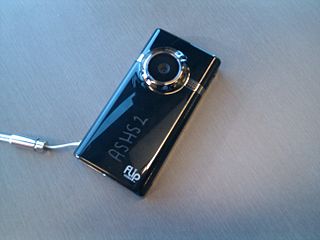
Digital video is an electronic representation of moving visual images (video) in the form of encoded digital data. This is in contrast to analog video, which represents moving visual images in the form of analog signals. Digital video comprises a series of digital images displayed in rapid succession, usually at 24 frames per second. Digital video has many advantages such as easy copying, multicasting, sharing and storage.

Video is an electronic medium for the recording, copying, playback, broadcasting, and display of moving visual media. Video was first developed for mechanical television systems, which were quickly replaced by cathode-ray tube (CRT) systems which, in turn, were replaced by flat panel displays of several types.

Videotape is magnetic tape used for storing video and usually sound in addition. Information stored can be in the form of either an analog or digital signal. Videotape is used in both video tape recorders (VTRs) and, more commonly, videocassette recorders (VCRs) and camcorders. Videotapes have also been used for storing scientific or medical data, such as the data produced by an electrocardiogram.

A framebuffer is a portion of random-access memory (RAM) containing a bitmap that drives a video display. It is a memory buffer containing data representing all the pixels in a complete video frame. Modern video cards contain framebuffer circuitry in their cores. This circuitry converts an in-memory bitmap into a video signal that can be displayed on a computer monitor.
The NewTek Video Toaster is a combination of hardware and software for the editing and production of NTSC standard-definition video. The plug-in expansion card initially worked with the Amiga 2000 computer and provides a number of BNC connectors on the exposed rear edge that provide connectivity to common analog video sources like VHS VCRs. The related software tools support video switching, luma keying, character generation, animation, and image manipulation.

Ampex Data Systems Corporation is an American electronics company founded in 1944 by Alexander M. Poniatoff as a spin-off of Dalmo-Victor. The name AMPEX is a portmanteau, created by its founder, which stands for Alexander M. Poniatoff Excellence. Ampex operates as Ampex Data Systems Corporation, a subsidiary of Delta Information Systems, and consists of two business units. The Silicon Valley unit, known internally as Ampex Data Systems (ADS), manufactures digital data storage systems capable of functioning in harsh environments. The Colorado Springs, Colorado, unit, referred to as Ampex Intelligent Systems (AIS), serves as a laboratory and hub for the company's line of industrial control systems, cyber security products and services and its artificial intelligence/machine learning technology.

The Quantel Paintbox was a dedicated computer graphics workstation for composition of broadcast television video and graphics. Produced by the British production equipment manufacturer Quantel, its design emphasized the studio workflow efficiency required for live news production.

A professional video camera is a high-end device for creating electronic moving images. Originally developed for use in television studios or with outside broadcast trucks, they are now also used for music videos, direct-to-video movies, corporate and educational videos, wedding videos, among other uses. Since the 2000s, most professional video cameras are digital professional video cameras.

A video camera is an optical instrument that captures videos. Video cameras were initially developed for the television industry but have since become widely used for a variety of other purposes.
Scanimate is an analog computer animation system developed from the late 1960s to the 1980s by Computer Image Corporation of Denver, Colorado.

A vision mixer is a device used to select between several different live video sources and, in some cases, compositing live video sources together to create visual effects.

A television studio, also called a television production studio, is an installation room in which video productions take place, either for the production of live television and its recording onto video tape or other media such as SSDs, or for the acquisition of raw footage for post-production. The design of a studio is similar to, and derived from, movie studios, with a few amendments for the special requirements of television production. A professional television studio generally has several rooms, which are kept separate for noise and practicality reasons. These rooms are connected via 'talkback' or an intercom, and personnel will be divided among these workplaces.

The production control room (PCR) or studio control room (SCR) is the place in a television studio in which the composition of the outgoing program takes place.

D-2 is a professional digital videocassette format created by Ampex and introduced in 1988 at the NAB Show as a composite video alternative to the component video D-1 format. It garnered Ampex a technical Emmy in 1989. Like D-1, D-2 stores uncompressed digital video on a tape cassette; however, it stores a composite video signal, rather than component video as with D-1. While component video is superior for advanced editing, especially when chroma key effects are used, composite video was more compatible with most analog facilities existing at the time.
Quantel was a company based in the United Kingdom and founded in 1973 that designed and manufactured digital production equipment for the broadcast television, video production and motion picture industries. It was headquartered in Newbury, Berkshire. The name Quantel came from Quantised Television, in reference to the process of converting a television picture into a digital signal.

2-inch quadruplex videotape was the first practical and commercially successful analog recording video tape format. It was developed and released for the broadcast television industry in 1956 by Ampex, an American company based in Redwood City, California. The first videotape recorder using this format was built the same year. This format revolutionized broadcast television operations and television production, since the only recording medium available to the TV industry until then was kinescope film.
The Technology and Engineering Emmy Awards, or Technology and Engineering Emmys, are one of two sets of Emmy Awards that are presented for outstanding achievement in engineering development in the television industry. The Technology and Engineering Emmy Awards are presented by the National Academy of Television Arts and Sciences (NATAS), while the separate Primetime Engineering Emmy Awards are given by its sister organization the Academy of Television Arts & Sciences (ATAS).
The Quantel Mirage, or DVM8000/1 "Digital Video Manipulator", was a digital real-time video effects processor introduced by Quantel in 1982. It was capable of warping a live video stream by texture mapping it onto an arbitrary three-dimensional shape, around which the viewer could freely rotate or zoom in real-time. It could also interpolate, or morph, between two different shapes. It was considered the first real-time 3D video effects processor.

Motion graphics are pieces of animation or digital footage which create the illusion of motion or rotation, and are usually combined with audio for use in multimedia projects. Motion graphics are usually displayed via electronic media technology, but may also be displayed via manual powered technology. The term distinguishes static graphics from those with a transforming appearance over time, without over-specifying the form. While any form of experimental or abstract animation can be called motion graphics, the term typically more explicitly refers to the commercial application of animation and effects to video, film, TV, and interactive applications.
International Video Corporation, or IVC, was a California company with large European operations that manufactured a number of models of middle to high-end video tape recorders, or VTRs, for industrial and professional use in the US, alongside a range of digital video Time Base Correctors and Special Effects units designed and manufactured in the UK. Their products were very popular in the industrial, scientific, research, medical, education, and institutional markets from the late 1960s through the 1980s.













